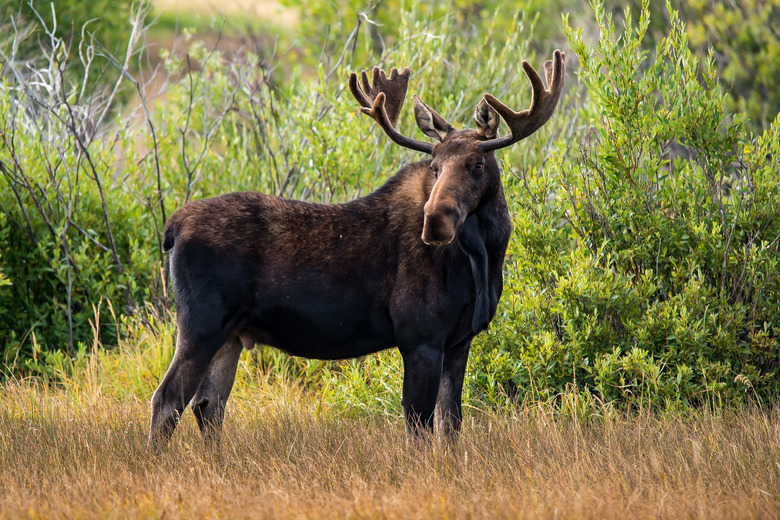Why Do Moose Lose Their Antlers?
Bull moose have antlers that can grow up to 6 feet wide. Antlers consist of bone, and while they spring from protrusions in the moose's head called pedicles, the actual growth occurs at the tip, rather than the base, as opposed to animals in the bovine family like cows, bison, buffalo, sheep, antelopes and goats whose horns continually grow. Animals in the Cervidae family, elk, caribou, deer have antlers. Most female of the species, except for caribou, do not have antlers, as the antlers' primary purpose is for attracting mates and fighting other males drawn to the same female.
TL;DR (Too Long; Didn't Read)
Moose and other animals belonging to the Cervidae family shed their antlers because of the levels of testosterone in their bloodstream at the end of breeding season.
Moose and Moose Antlers
Moose and Moose Antlers
If someone says moose horns instead of antlers, they are using the wrong term. Only cows, goats, sheep and other animals in the bovine family grow horns. Horns contain keratin, which is not bone, but is instead the same material that makes up hair and fingernails. Female moose do not have antlers, as they do not engage in fighting during the mating season. As antlers grow, a form of velvety growth covers the bone until the moose rubs it off just prior to the mating season. Once the rutting season – the mating season – completes, antlers fall from the mooses' heads, usually at the same time, but sometimes one side drops before the other. All animals in the Cervidae family shed their antlers yearly.
Moose Anatomy and Size
Moose Anatomy and Size
Moose are the largest members of the Cervidae family. As a hoofed animal – ungulate – these creatures grow quite large. Adult prime-condition males can weigh between 1,200 and 1,650 pounds. Females are smaller, weighing in at between 800 and 1,100 pounds. Both have bodies that can grow up to 10 feet long and stand at least 6 to 7 feet tall at the ridge between their shoulder blades. The largest moose subspecies in the U.S. lives in Alaska, called the tundra moose. Females generally breed in their second year and produce one to two calves during the summer after carrying them for 7 1/2 months.
Antler Growth and Shedding
Antler Growth and Shedding
Dr. Bronson Strickland of the Mississippi State University Extension office writes in an article that the photoperiod – the length of sunlight in a 24-hour period – and the animal's hormones drive the annual antler cycle. Changes in the amount of daylight cause the buck's hormones to generate testosterone, which activates antler growth. During the spring and summer, while antlers grow, testosterone levels go up and down.
As daylight decreases with autumn, testosterone ramps up for the breeding season, causing the antlers to stop growing. While the antlers grow they are softer, but as mating season nears, antlers harden and gain the velvet covering, which the bucks rub off on trees and saplings before mating. Mating season generally occurs before winter begins in earnest, through September to October, after which the males lose their antlers.
Cite This Article
MLA
Brenner, Laurie. "Why Do Moose Lose Their Antlers?" sciencing.com, https://www.sciencing.com/do-moose-lose-antlers-7162071/. 22 November 2019.
APA
Brenner, Laurie. (2019, November 22). Why Do Moose Lose Their Antlers?. sciencing.com. Retrieved from https://www.sciencing.com/do-moose-lose-antlers-7162071/
Chicago
Brenner, Laurie. Why Do Moose Lose Their Antlers? last modified March 24, 2022. https://www.sciencing.com/do-moose-lose-antlers-7162071/
